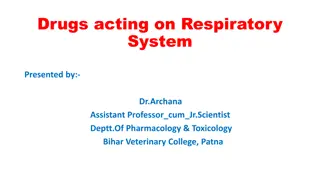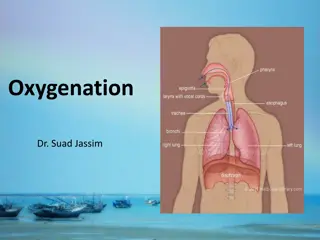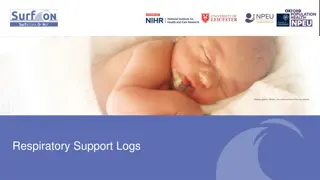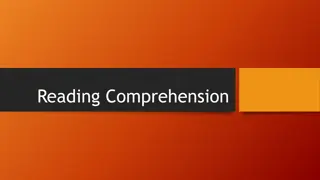Functions of the Respiratory System and Ventilation Mechanism
The respiratory system performs crucial functions such as ventilation to facilitate gas exchange, maintaining pH balance, and enabling vocal sounds. It consists of the upper and lower respiratory systems, including structures like the nose, trachea, bronchi, and alveoli. The system's epithelium, the
7 views • 43 slides
Understanding the Respiratory System and Its Functions
Within the complex respiratory system, the goal is to provide oxygen to tissues and remove CO2. It consists of airways, muscles, and centers. Functions include gas exchange, phonation, and pulmonary defense. The system also performs non-respiratory functions like converting Angiotensin I to II, regu
3 views • 29 slides
Understanding Drugs Acting on the Respiratory System for Effective Treatment
Explore the classification and actions of drugs targeting the respiratory system, including antitussives, expectorants, respiratory stimulants, bronchodilators, and mucolytics. Discover how these medications work to suppress coughs, promote fluidity of bronchial secretions, and stimulate respiratory
0 views • 14 slides
Overview of the Respiratory System
The human respiratory system facilitates gas exchange crucial for cellular energy production. Comprised of the upper and lower respiratory systems, it filters, warms, and humidifies air before reaching the alveoli for efficient exchange. Functions include gas exchange, air movement, and protection f
0 views • 24 slides
Collaborating to Combat Sepsis: Role of Respiratory Therapists
Sepsis is a critical condition involving infection and inflammation, where the body's response causes widespread symptoms. Learn about the continuum of sepsis, its pathophysiology, and respiratory warning signs. Respiratory therapists play a crucial role in identifying and managing sepsis, with stat
1 views • 14 slides
Understanding the Respiratory System and its Vital Functions
The respiratory system plays a crucial role in our bodies by taking in oxygen and expelling carbon dioxide. Key components include the lungs, diaphragm, bronchi, and alveoli. Air enters through the nose or mouth, travels down the trachea to the lungs, where oxygen is absorbed into the bloodstream an
0 views • 26 slides
Anatomy of the Respiratory System in Birds: A Detailed Overview
The respiratory system in birds, including poultry, consists of various components such as nostrils, nasal cavities, larynx, trachea, syrinx, air sacs, and lungs. Each part plays a crucial role in respiration, with unique features adapted to avian physiology. Understanding the anatomy of the avian r
1 views • 19 slides
Understanding Acute Respiratory Infections (ARI): Symptoms, Classification, and Transmission
Acute Respiratory Infections (ARI), characterized by sudden onset respiratory symptoms affecting the respiratory system from nose to alveoli, are a complex group of diseases caused by various agents. Symptoms include pain in the sinuses, nasal congestion, fatigue, sinusitis, coughing, and more. The
0 views • 16 slides
Understanding the Human Respiratory System: Anatomy, Functions, and Importance
The human respiratory system plays a vital role in gas exchange and maintaining overall health. This article delves into the anatomy of the respiratory system, its main functions, such as gas exchange and air filtration, and the importance of respiratory health. Learn about the different components,
0 views • 13 slides
Respiratory Health Insights and Updates by Dr. Zeina Aoun Bacha, MD
Explore key topics in respiratory health with Dr. Zeina Aoun Bacha, MD, including World Respiratory Diseases Day, Organizing Pneumonia, Sputnik Five Vaccine, and AstraZeneca Vaccine. Stay informed on important respiratory events and vaccination developments.
1 views • 10 slides
Understanding the Respiratory System: An Overview
The respiratory system, consisting of the upper and lower respiratory tracts, is responsible for ventilation and gas exchange. Learn about the anatomy, common symptoms like dyspnea and cough, and how the system functions anatomically and physiologically. Understanding these aspects can help in recog
0 views • 15 slides
Understanding Oxygenation and Respiratory System Function
Explore essential terms like alveoli, perfusion, atelectasis, and more in the context of respiratory system function. Learn about lung anatomy, oxygenation processes, and common respiratory disorders like dyspnea and hypoxia. Discover the crucial factors for maintaining normal respiratory function.
0 views • 35 slides
Viral Infections of the Respiratory System Lecture Summary & Quiz
This lecture covers viral infections of the respiratory system, focusing on Avian flu, Influenza Virus, Respiratory Syncytial Virus, Human metapneumovirus, Parainfluenza viruses, Measles, and Mumps virus. It includes information on the structure, symptoms, lab diagnosis, treatment, and prevention of
0 views • 11 slides
Understanding Respiratory System Disorders: Sinusitis, Rhinitis, Emphysema, and COPD
This informative content delves into common respiratory issues such as sinusitis, rhinitis, emphysema, and COPD. It provides detailed information on the symptoms, diagnostic criteria, and rating formulas for each condition. The content also touches upon military service-related respiratory problems.
0 views • 15 slides
Understanding Neural Control of Respiration in the Respiratory System
Explore the intricate mechanisms of neural control of respiration within the respiratory system, focusing on key components such as the respiratory center in the medulla and the role of inspiratory ramp signals in regulating breathing rhythms. Gain insights into the automatic and voluntary aspects o
1 views • 35 slides
Sniff Nasal Inspiratory Pressure (SNIP): Assessing Respiratory Muscle Strength
SNIP is a sensitive non-invasive test that measures inspiratory muscle strength by assessing nasal pressures during a sniff maneuver. It is a valuable tool for early detection of respiratory muscle decline, providing insights into potential threats like hypercapnic respiratory failure, impaired coug
0 views • 11 slides
Neonatal Respiratory Support Study Overview
This study focuses on evaluating the primary outcomes of length of hospital stay post-birth and incidence of severe respiratory failure in infants receiving respiratory support. Detailed logs are maintained daily until the infant is off respiratory support or discharged. The study is funded by NIHR.
0 views • 19 slides
Cockroach Respiratory System Overview
Cockroach respiratory system is tracheal-based, featuring stigmata for gas exchange. Trachea lead to tracheoles for oxygen transport to tissues. Tergo-sternal muscles aid in respiration, with inspiration expanding the body cavity for air intake and expiration expelling CO2. Control of respiratory mo
0 views • 8 slides
Methods of Imaging the Respiratory System
This lecture discusses various methods of imaging the respiratory system, including plain films, radionuclide imaging, CT scans, ultrasound for pleural disease, MRI, and bronchography. The normal anatomy relevant to respiratory system angiography is also highlighted through a series of images.
0 views • 27 slides
Anesthesia and Upper Respiratory Tract Infections in Children
This presentation discusses the etiology, differential diagnoses, and management of upper respiratory tract infections (URIs) in children undergoing anesthesia. It covers causes of bronchoconstriction, adverse respiratory effects of URIs, and current anesthetic recommendations. The content emphasize
0 views • 52 slides
Respiratory Care in FSHD: Guidelines and Management Overview
Comprehensive overview of respiratory care in Facioscapulohumeral Muscular Dystrophy (FSHD) based on the American Academy of Neurology guidelines. Covers incidence of respiratory insufficiency, assessment of lung function, treatment options including noninvasive ventilation, and strategies for maint
0 views • 16 slides
Understanding the Control of Breathing and Respiratory Rhythm
The content delves into the intricacies of the control of breathing, emphasizing the role of the medulla oblongata in regulating respiratory activity. It explores factors modifying breathing patterns, respiratory consequences of changing PO2, PCO2, and pH, and the functions of central and peripheral
0 views • 16 slides
Understanding the Respiratory System Components and Functions
The respiratory system consists of two primary subdivisions: the Air Conducting portion and the Respiratory portion. The Air Conducting portion includes nasal cavity, naso-pharynx, larynx, trachea, bronchi, bronchioles, and terminal bronchioles, providing a pathway to and from the lungs while condit
0 views • 12 slides
Overview of Respiratory System Components and Functions
The respiratory system consists of vital components like pulmonary compliance and surfactant, crucial for proper lung function. Pulmonary compliance reflects the lung's ease of expansion, influenced by factors like lung elasticity and surface tension. Surfactant, produced by type II alveolar cells,
0 views • 15 slides
Understanding Nasal Cavity Histology and Respiratory Structures
The detailed information provided covers the histological structures of the nasal cavity, including the vestibule, respiratory mucosa, nasal septum, olfactory mucosa, and paranasal sinuses. It also delves into the microscopic structures of the wall of the trachea and primary bronchi. The respiratory
0 views • 11 slides
Respiratory Tract Anatomy Overview
The respiratory tract anatomy includes various structures like mucosa, submucosa, and adventitia in the trachea, bronchi, bronchioles, and terminal bronchioles. Each component has specific compositions and functions, ranging from respiratory epithelium to smooth muscle layers. The images provide a v
0 views • 15 slides
Understanding Equine Influenza: An Overview of Respiratory Tract Infections in Horses
Equine influenza is a contagious upper respiratory infection in horses caused by influenza viruses. This article covers the anatomy of the equine respiratory tract, signs, diagnosis, treatment, prevention, and prognosis of equine influenza. It also discusses the histological structure of the respira
0 views • 18 slides
Understanding the Respiratory System and Its Functions
The respiratory system is vital for gas exchange in the body, involving processes like pulmonary ventilation, external and internal respiration. It includes organs like the nose, pharynx, larynx, and trachea, which help in conducting air to the alveoli. This system facilitates the exchange of oxygen
1 views • 14 slides
Innovative Technology for Diagnosing and Managing Respiratory Diseases
Monash University researchers have developed a groundbreaking non-invasive technology to diagnose and manage respiratory lung diseases, such as cystic fibrosis and lung cancer. The technology, utilizing four-dimensional X-ray velocity imaging, provides high-definition real-time images of airflow in
0 views • 4 slides
Explore the Intriguing World of the Respiratory System
Discover fascinating facts about the respiratory system, including the anatomy of the lungs, how they help you breathe, and the interconnectedness of body systems. Learn how crucial oxygen is for sustaining life and how your respiratory organs work in tandem. Explore the essential role of the respir
0 views • 15 slides
Understanding the Respiratory System: Lesson Objectives and Anatomy Explained
Explore the intricacies of the respiratory system as you delve into the lesson objectives and anatomy presented by Assistant Teacher Fatima Kareem. Discover the parts of the respiratory system, from the nose to the lungs, and learn how air travels through this vital system to facilitate breathing an
0 views • 10 slides
Understanding the Cardio-Respiratory System in GCSE PE
Explore the structure and function of the cardio-respiratory system in GCSE PE, including the pathway of air, gaseous exchange, cardiac cycle, and key terminologies. Learn how the respiratory system serves to deliver oxygen to muscles and remove carbon dioxide. Discover the mechanisms of breathing,
0 views • 37 slides
Understanding Respiratory Rate and Ventilation in Nursing Practice
This lecture focuses on the vital signs related to respiratory rate, emphasizing the three processes of respiration: ventilation, diffusion, and perfusion. Nurses assess ventilation by observing the rate, depth, and rhythm of respiratory movement, crucial in recognizing normal thoracic and abdominal
0 views • 51 slides
Understanding Viral Infections of the Respiratory System
Respiratory viral infections are common and primarily caused by viruses, leading to morbidity and time off work. They can range from mild upper respiratory tract infections to severe lower respiratory tract infections like pneumonia. Various viruses like influenza, parainfluenza, respiratory syncyti
0 views • 23 slides
Pediatric Respiratory Infections: An Overview of Cases and Physiology
This review delves into selected cases of respiratory infections in children presented by Dr. David L. Smith, focusing on the anatomical and physiological aspects of the pediatric airway and respiratory system. It discusses respiratory failure in infants and small children, metabolic demands, cyanos
0 views • 49 slides
Alaska State Virology Lab Respiratory Virus Surveillance Program
The Alaska State Virology Lab's Respiratory Virus Surveillance Program accepts specimens from across Alaska, ranging from large hospitals to single physician clinics. They collect specimens representing CLI/ILI weekly and are interested in Severe Acute Respiratory Illness samples, among others. The
1 views • 6 slides
Understanding the Respiratory System: An Overview
The respiratory system comprises the upper and lower respiratory tracts, responsible for air movement and gas exchange. It relies on the cardiovascular system for proper blood flow. The anatomy involves structures in the upper and lower tracts, with common symptoms like dyspnea and cough indicating
0 views • 20 slides
Understanding Respiratory System Terminology and Disorders
Explore the terminology and components of the respiratory system including the upper and lower respiratory tract, respiration process, word roots, and common respiratory disorders. Learn the meanings of terms like apnoea, dyspnoea, pneumonia, and more. Enhance your knowledge of respiratory health an
0 views • 12 slides
Comprehensive Overview of Respiratory Block for Medical Students
This respiratory block introduces students to the anatomy, histology, muscles involved in respiration, embryology, radiological anatomy, and management of respiratory disorders. It covers topics like the nasal cavity, pharynx, larynx, trachea, bronchi, lungs, pleura, bronchial tree, and mediastinum.
0 views • 23 slides
Understanding the Respiratory System and Ventilation Lab Activities
Dive into the intricate workings of the respiratory system and explore various lab activities related to ventilation. From studying respiratory cycles to simulating spirometry, understanding muscle functions, exploring gas exchange in tissues, and controlling respiration, this comprehensive guide pr
0 views • 24 slides







































